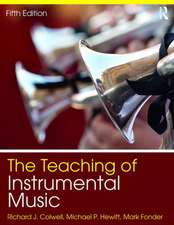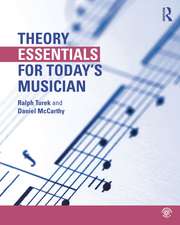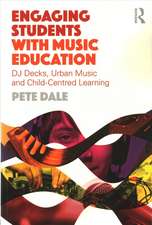Dynamic Group-Piano Teaching: Transforming Group Theory into Teaching Practice
Autor Pamela Pikeen Limba Engleză Hardback – 26 mai 2017
| Toate formatele și edițiile | Preț | Express |
|---|---|---|
| Paperback (1) | 437.04 lei 6-8 săpt. | |
| Taylor & Francis – 16 mai 2017 | 437.04 lei 6-8 săpt. | |
| Hardback (1) | 1006.60 lei 6-8 săpt. | |
| Taylor & Francis – 26 mai 2017 | 1006.60 lei 6-8 săpt. |
Preț: 1006.60 lei
Preț vechi: 1227.57 lei
-18% Nou
Puncte Express: 1510
Preț estimativ în valută:
192.64€ • 199.41$ • 162.82£
192.64€ • 199.41$ • 162.82£
Carte tipărită la comandă
Livrare economică 06-20 martie
Preluare comenzi: 021 569.72.76
Specificații
ISBN-13: 9781138241428
ISBN-10: 1138241423
Pagini: 252
Ilustrații: 30
Dimensiuni: 178 x 254 x 16 mm
Greutate: 0.64 kg
Ediția:1
Editura: Taylor & Francis
Colecția Routledge
Locul publicării:Oxford, United Kingdom
ISBN-10: 1138241423
Pagini: 252
Ilustrații: 30
Dimensiuni: 178 x 254 x 16 mm
Greutate: 0.64 kg
Ediția:1
Editura: Taylor & Francis
Colecția Routledge
Locul publicării:Oxford, United Kingdom
Cuprins
Acknowledgements
List of Figures
Preface
Introduction
Section 1 Background of Group-Piano & Working With Groups
Chapter 1 Group-Piano 101
Objectives
Historical Overview of Group-Piano and Its Context Today
Categories of Group-Piano Lessons
Occasional Group Classes
Regular Group Classes
3 Weeks of Private Lessons; Group Lesson Only During 4th Week
4 Weeks of Private Lessons; Group Lesson Also During 4th Week
Private (or Partner) Lesson & Group Class Every Week
A Note About Partner Lessons
A Private Lessons and a Group Lesson on Alternating Weeks
Occasional Group Camps
Group-Piano Only and the Teaching Space
Benefits of Group-Piano for Student and Teacher
Considerations Regarding Group-Piano
Special Skills Required of a Group-Piano Teacher
Student Readiness for Group-Piano Lessons
Teacher Readiness for Group-Piano Lessons
A Final Note of Caution
Pedagogy in Action (Questions to Answer)
References for Chapter 1
Chapter 2 Brief Overview of Learning Theories That Teachers Should Consider
Objectives
Introduction
Learning Theories
What is Learning?
Behaviorism
Psychosocial Development, Cognitive Development & Human Learning
Other Theorists & Theories for Teachers to Consider and Explore
Discussion & Implementation in the Piano Class
Reflection on the Use of Learning & Developmental Theories in the Group-Piano Setting
Two Sample Classes
Pedagogy in Action
References for Chapter 2
Chapter 3 Group Theory and Group Dynamics in the Piano Class
Objectives
Two Vignettes of Group-Piano Students
Vignette One: First-Year Group Piano
Vignette Two: Beginning Seven-Year-Old Group Piano
The Power of the Group
Group Dynamics and Group Growth: Background & Relevance to Group-Piano
Stages of Group Growth
Forming
Storming
Norming & Performing
Adjourning
Discussions of the Stages of Group Growth and Cohesiveness
Priming the Group for Success and Considerations for Group-Piano Instructors
Pedagogy in Action
Additional Reading & Exploration
References for Chapter 3
Chapter 4 Addressing Individual Learning Styles Within the Group-Piano Class
Objectives
Preferred Learning Modes
Individual Personality Types & Learning Styles
Myers-Briggs Type Indicator
Kiersey & Golay Personality Types
Kolb’s Learning-Style Preferences
Reinforcing Cognitive Strategies & Learning Styles in the Piano Lab
Useful Cognitive Strategies
Using Learning Theories & Kolb’s Learning Styles in the Group-Piano Class
Engaging Active Experimenters & Reflective Observers in Technical Exercises
Engaging Thinkers & Feelers in Improvisation
Conclusion
Pedagogy in Action
References for Chapter 4
Section 2 Group-Piano Students: Adults
Chapter 5 The Music Major: College-Level Group Piano
Objectives
Introduction
Philosophy for Including Piano Proficiency in the Undergraduate Music Curriculum
Suggested & Required Skills
Placement Tests
NASM Requirements & Recommendations
Overview of Piano Skills Required of Music Majors
Assessment
Syllabus
Purpose & Materials
Piano Proficiency Exam
After the Proficiency & Supplemental Resources
College Text Overviews
Alfred’s Group Piano for Adults
Piano for the Developing Musician
Keyboard Musicianship
Contemporary Class Piano
Piano Lab
Pedagogy in Action
References for Chapter 5
Chapter 6 The Non-Major: Adults Groups for College Credit
Objectives
The Non-Music Major
Philosophy & Theory
Assessment
Individual Assessment
Piano Placements
College Texts for Non-Majors
Piano 101
Piano for Pleasure
Keyboard Fundamentals
Pedagogy in Action
References for Chapter 6
Chapter 7 Leisure Adults in the Independent Studio, Community Schools, and Other Locations
Objectives
Introduction
Grouping Adults
Andragogy
Lifespan Development
Characteristics of Adult Learners
Common Characteristics of Adults & Considerations for Teachers
Cognitive Changes Associated with Age
Physical Changes Associated with Age
Other Implications of Age on Piano Study: The Importance of Clarity
Needs of the Leisure Student and the Curriculum
Serious Music Study or RMM: Two Paths Toward Musical Development
Considerations when Designing Curriculum and Choosing Materials
Adult Leisure Text Review
Adult Piano Adventures
Adult Piano Method (Hal Leonard Student Library)
Piano Fun for Adult Beginners & Piano Fun
Play Piano Now!
I Used to Play Piano
Returning to the Piano
Handbooks for Teachers of Adults
Making Music at the Piano: Learning Strategies for Adult Students
Recreational Music Making Handbook for Piano Teachers
Pedagogy in Action
References for Chapter 7
Section 3 Group-Piano Students: Children
Chapter 8 Overview of Group Music Programs for Children
Objectives
Introduction
Historic Group Programs for Children – European Influences
Dalcroze Eurythmics
Applications to Group-Piano
The Kodlày Method
Applications to Group-Piano
Orff-Schulwerk
Applications to Group-Piano
Asian Influences
The Suzuki Method
Applications to Group-Piano
Yamaha Music Education Program
Applications to Group-Piano
North American Influences
Kindermusik International
Musikgarten
Music for Young Children
Pedagogy in Action
References for Chapter 8
Chapter 9 Group-Piano for Children in the Independent Studio & K-12 Schools
Objectives
Overview of Group-Piano for Children
Philosophy & Theory of Teaching Children in Groups
Typical Types of Group-Piano for Children & Curricular Considerations
Methods & Materials for Children in Beginning Group-Piano
Average-Age Beginning Methods
Alfred’s Basic Group Piano Course
The Music Tree
Other Methods That May Be Used
Resources for Advancing Groups
Ensemble Resources
Alfred Basic Piano Library Ensemble Books
Hal Leonard Student Piano Library Ensemble Books
Ogilvy Music Ensembles
Ensemble Music for Group Piano
PianoTeams
Games
Teacher Books on Games
Useful Books for Theory, Improvisation, Composition, & Music History
General Resources for Teachers
Theory
Resources for Teachers
Books for Students
Improvisation
Composition
Books for Teachers
Books for Students
Music History & World Music
Materials Designed for Group-Piano Camps
Books Specifically for K-12 Piano Classes
Pedagogy in Action
References & Teacher Resources for Chapter 9
Section 4 The Group-Piano Instructor
Chapter 10 Advantages and Disadvantages of Group Teaching & Additional Thoughts on Assessment from the Instructor’s Perspective
Objectives
Advantages of Group-Piano Teaching
Disadvantages of Teaching Group-Piano
Assessment
Pedagogy in Action
References for Chapter 10
Chapter 11 Characteristics of Effective Group-Piano Teachers
Objectives
Effective Group Teachers
Curriculum
Lesson Planning & Realization
Group Engagement
Measurement of Individual Outcomes
Student Motivation
Conclusions
Pedagogy in Action
References & Resources for Chapter 11
Chapter 12 Common Pitfalls of Beginning Group-Piano Instructors & How to Avoid These Mistakes
Objectives
Introduction
Policy & Procedural Issues
Lesson Scheduling & Length of Term
Unclear or Unstated Expectations for Students and Families
Curricular Issues
Inappropriate Lessons & Materials
Lack of Specific Long-Term Goals & Objectives
Inadequate Reinforcement
Teaching Difficulties, Issues, & Assessment Concerns
Teaching Not Telling
Pacing, Flexibility, & Wasted Time
Too Few Group Activities & Little Serious Learning or Musicianship
Classroom Management
Individual & Group Assessment
Final Thoughts & Ideas
Pedagogy in Action
References for Chapter 12
Chapter 13 Establishing Trust Within the Group
Objectives
Introduction
Teacher’s Role
Sample Student Activities
Rehearsing Ensemble Repertoire
Improvising Accompaniments
Pedagogy in Action
References for Chapter 13
Chapter 14 Logistics of Teaching Group-Piano
Objectives
Scheduling
Surveys
Optimal Time of Day
Marketing
Space in the Studio – Considerations
Ancillary Materials
Books & Multiple Copies of Music
Games & Manipulatives
Pedagogy in Action
References for Chapter 14
Chapter 15 Technology for the Group-Piano Instructor
Objectives
Introduction
Basic Technology
Digital & Electronic Pianos
Computers, Audio, & Visual Aids
Additional Technology to Enhance the Learning Experience
Keeping Up With Technological Change
Pedagogy in Action
References & Resources for Chapter 15
Appendix A.1
Appendix A.2
Appendix A.3
Appendix B
Appendix C.1
Appendix C.2
Appendix C.3
Appendix D.1
Appendix D.2
Appendix E.1
Appendix E.2
Appendix E.3
Appendix E.4
Appendix E.5
References
Index
List of Figures
Preface
Introduction
Section 1 Background of Group-Piano & Working With Groups
Chapter 1 Group-Piano 101
Objectives
Historical Overview of Group-Piano and Its Context Today
Categories of Group-Piano Lessons
Occasional Group Classes
Regular Group Classes
3 Weeks of Private Lessons; Group Lesson Only During 4th Week
4 Weeks of Private Lessons; Group Lesson Also During 4th Week
Private (or Partner) Lesson & Group Class Every Week
A Note About Partner Lessons
A Private Lessons and a Group Lesson on Alternating Weeks
Occasional Group Camps
Group-Piano Only and the Teaching Space
Benefits of Group-Piano for Student and Teacher
Considerations Regarding Group-Piano
Special Skills Required of a Group-Piano Teacher
Student Readiness for Group-Piano Lessons
Teacher Readiness for Group-Piano Lessons
A Final Note of Caution
Pedagogy in Action (Questions to Answer)
References for Chapter 1
Chapter 2 Brief Overview of Learning Theories That Teachers Should Consider
Objectives
Introduction
Learning Theories
What is Learning?
Behaviorism
Psychosocial Development, Cognitive Development & Human Learning
Other Theorists & Theories for Teachers to Consider and Explore
Discussion & Implementation in the Piano Class
Reflection on the Use of Learning & Developmental Theories in the Group-Piano Setting
Two Sample Classes
Pedagogy in Action
References for Chapter 2
Chapter 3 Group Theory and Group Dynamics in the Piano Class
Objectives
Two Vignettes of Group-Piano Students
Vignette One: First-Year Group Piano
Vignette Two: Beginning Seven-Year-Old Group Piano
The Power of the Group
Group Dynamics and Group Growth: Background & Relevance to Group-Piano
Stages of Group Growth
Forming
Storming
Norming & Performing
Adjourning
Discussions of the Stages of Group Growth and Cohesiveness
Priming the Group for Success and Considerations for Group-Piano Instructors
Pedagogy in Action
Additional Reading & Exploration
References for Chapter 3
Chapter 4 Addressing Individual Learning Styles Within the Group-Piano Class
Objectives
Preferred Learning Modes
Individual Personality Types & Learning Styles
Myers-Briggs Type Indicator
Kiersey & Golay Personality Types
Kolb’s Learning-Style Preferences
Reinforcing Cognitive Strategies & Learning Styles in the Piano Lab
Useful Cognitive Strategies
Using Learning Theories & Kolb’s Learning Styles in the Group-Piano Class
Engaging Active Experimenters & Reflective Observers in Technical Exercises
Engaging Thinkers & Feelers in Improvisation
Conclusion
Pedagogy in Action
References for Chapter 4
Section 2 Group-Piano Students: Adults
Chapter 5 The Music Major: College-Level Group Piano
Objectives
Introduction
Philosophy for Including Piano Proficiency in the Undergraduate Music Curriculum
Suggested & Required Skills
Placement Tests
NASM Requirements & Recommendations
Overview of Piano Skills Required of Music Majors
Assessment
Syllabus
Purpose & Materials
Piano Proficiency Exam
After the Proficiency & Supplemental Resources
College Text Overviews
Alfred’s Group Piano for Adults
Piano for the Developing Musician
Keyboard Musicianship
Contemporary Class Piano
Piano Lab
Pedagogy in Action
References for Chapter 5
Chapter 6 The Non-Major: Adults Groups for College Credit
Objectives
The Non-Music Major
Philosophy & Theory
Assessment
Individual Assessment
Piano Placements
College Texts for Non-Majors
Piano 101
Piano for Pleasure
Keyboard Fundamentals
Pedagogy in Action
References for Chapter 6
Chapter 7 Leisure Adults in the Independent Studio, Community Schools, and Other Locations
Objectives
Introduction
Grouping Adults
Andragogy
Lifespan Development
Characteristics of Adult Learners
Common Characteristics of Adults & Considerations for Teachers
Cognitive Changes Associated with Age
Physical Changes Associated with Age
Other Implications of Age on Piano Study: The Importance of Clarity
Needs of the Leisure Student and the Curriculum
Serious Music Study or RMM: Two Paths Toward Musical Development
Considerations when Designing Curriculum and Choosing Materials
Adult Leisure Text Review
Adult Piano Adventures
Adult Piano Method (Hal Leonard Student Library)
Piano Fun for Adult Beginners & Piano Fun
Play Piano Now!
I Used to Play Piano
Returning to the Piano
Handbooks for Teachers of Adults
Making Music at the Piano: Learning Strategies for Adult Students
Recreational Music Making Handbook for Piano Teachers
Pedagogy in Action
References for Chapter 7
Section 3 Group-Piano Students: Children
Chapter 8 Overview of Group Music Programs for Children
Objectives
Introduction
Historic Group Programs for Children – European Influences
Dalcroze Eurythmics
Applications to Group-Piano
The Kodlày Method
Applications to Group-Piano
Orff-Schulwerk
Applications to Group-Piano
Asian Influences
The Suzuki Method
Applications to Group-Piano
Yamaha Music Education Program
Applications to Group-Piano
North American Influences
Kindermusik International
Musikgarten
Music for Young Children
Pedagogy in Action
References for Chapter 8
Chapter 9 Group-Piano for Children in the Independent Studio & K-12 Schools
Objectives
Overview of Group-Piano for Children
Philosophy & Theory of Teaching Children in Groups
Typical Types of Group-Piano for Children & Curricular Considerations
Methods & Materials for Children in Beginning Group-Piano
Average-Age Beginning Methods
Alfred’s Basic Group Piano Course
The Music Tree
Other Methods That May Be Used
Resources for Advancing Groups
Ensemble Resources
Alfred Basic Piano Library Ensemble Books
Hal Leonard Student Piano Library Ensemble Books
Ogilvy Music Ensembles
Ensemble Music for Group Piano
PianoTeams
Games
Teacher Books on Games
Useful Books for Theory, Improvisation, Composition, & Music History
General Resources for Teachers
Theory
Resources for Teachers
Books for Students
Improvisation
Composition
Books for Teachers
Books for Students
Music History & World Music
Materials Designed for Group-Piano Camps
Books Specifically for K-12 Piano Classes
Pedagogy in Action
References & Teacher Resources for Chapter 9
Section 4 The Group-Piano Instructor
Chapter 10 Advantages and Disadvantages of Group Teaching & Additional Thoughts on Assessment from the Instructor’s Perspective
Objectives
Advantages of Group-Piano Teaching
Disadvantages of Teaching Group-Piano
Assessment
Pedagogy in Action
References for Chapter 10
Chapter 11 Characteristics of Effective Group-Piano Teachers
Objectives
Effective Group Teachers
Curriculum
Lesson Planning & Realization
Group Engagement
Measurement of Individual Outcomes
Student Motivation
Conclusions
Pedagogy in Action
References & Resources for Chapter 11
Chapter 12 Common Pitfalls of Beginning Group-Piano Instructors & How to Avoid These Mistakes
Objectives
Introduction
Policy & Procedural Issues
Lesson Scheduling & Length of Term
Unclear or Unstated Expectations for Students and Families
Curricular Issues
Inappropriate Lessons & Materials
Lack of Specific Long-Term Goals & Objectives
Inadequate Reinforcement
Teaching Difficulties, Issues, & Assessment Concerns
Teaching Not Telling
Pacing, Flexibility, & Wasted Time
Too Few Group Activities & Little Serious Learning or Musicianship
Classroom Management
Individual & Group Assessment
Final Thoughts & Ideas
Pedagogy in Action
References for Chapter 12
Chapter 13 Establishing Trust Within the Group
Objectives
Introduction
Teacher’s Role
Sample Student Activities
Rehearsing Ensemble Repertoire
Improvising Accompaniments
Pedagogy in Action
References for Chapter 13
Chapter 14 Logistics of Teaching Group-Piano
Objectives
Scheduling
Surveys
Optimal Time of Day
Marketing
Space in the Studio – Considerations
Ancillary Materials
Books & Multiple Copies of Music
Games & Manipulatives
Pedagogy in Action
References for Chapter 14
Chapter 15 Technology for the Group-Piano Instructor
Objectives
Introduction
Basic Technology
Digital & Electronic Pianos
Computers, Audio, & Visual Aids
Additional Technology to Enhance the Learning Experience
Keeping Up With Technological Change
Pedagogy in Action
References & Resources for Chapter 15
Appendix A.1
Appendix A.2
Appendix A.3
Appendix B
Appendix C.1
Appendix C.2
Appendix C.3
Appendix D.1
Appendix D.2
Appendix E.1
Appendix E.2
Appendix E.3
Appendix E.4
Appendix E.5
References
Index
Notă biografică
Pamela D. Pike is Aloysia L. Barineau Associate Professor of Piano Pedagogy at Louisiana State University.
Descriere
Dynamic Group-Piano Teaching provides future teachers of group piano with an extensive framework of concepts, upon which effective and dynamic teaching strategies can be explored and developed. Within 15 chapters, it encompasses learning theory, group process, and group dynamics within the context of group-piano instruction. This book encourages teachers to transfer learning and group dynamics theory into classroom practice. As a graduate piano pedagogy text book, supplement for pedagogy classes, or as a resource for graduate teaching assistants and professional piano teachers, the book examines learning theory, student needs, assessment and specific issues for the group-piano instructor.












